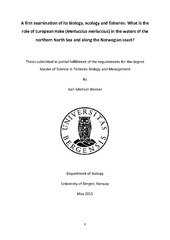| dc.contributor.author | Werner, Karl-Michael | eng |
| dc.date.accessioned | 2015-09-07T12:11:40Z | |
| dc.date.available | 2015-09-07T12:11:40Z | |
| dc.date.issued | 2015-05-29 | |
| dc.date.submitted | 2015-05-29 | eng |
| dc.identifier.uri | http://hdl.handle.net/1956/10408 | |
| dc.description.abstract | Based on the results from the annual stock assessment of the European hake (Merluccius merluccius) by the International Council for the Exploration of the Sea, a fourfold increase of the spawning stock biomass can be observed over the last decade. As a leading country in fisheries research, Norway has as of yet contributed surprisingly little to the research to hake. In this study I present first attempts to describe the distribution, abundance as well as spawning and nursery areas, and prey spectrum of the European hake in the North Sea and along the Norwegian coast. Survey data from the Institute of Marine Research from 2006-2014 and landing records obtained from the Norwegian Directorate of Fisheries from 2000-2014 as well as stomachs collected in 2014 were examined and analyzed. In the period analyzed catch data showed increasing landings from bottom trawl fisheries in the North Sea and to a lesser extent in the gillnet fisheries along the Norwegian mid-west coast. Concurrently abundance index of hake (CPUE) increased in the North Sea, the Skagerrak and along the coast, showing highest densities east of Shetland Islands in July. It appears that the increase in commercial hake landings can be related to the observed increase in spawning stock biomass. Fish in spawning condition were found along the slope west of the Norwegian trench. As a result of the current regimes in the North Sea hake egg and larvae may be transported from the spawning grounds on the south-west Norwegian trench into the Skagerrak. Smallest individuals from 6.5-10.5 cm were mainly located in the Skagerrak, while individuals from 10.5-25.5 cm were caught in large numbers both east of the Shetlands and the Skagerrak. In terms of %F Norway pout was shown to be the most important prey species, followed by Atlantic herring and Atlantic mackerel. An overlap of the hake distribution with areas of highest abundance of Norway pout as well as feeding grounds for herring and mackerel may explain their dietary importance. Results from this study provide new and essential insights into characteristics of a commercially valuable and ecologically increasingly important species. | en_US |
| dc.format.extent | 2893935 bytes | eng |
| dc.format.mimetype | application/pdf | eng |
| dc.language.iso | eng | eng |
| dc.publisher | The University of Bergen | en_US |
| dc.subject | European hake | eng |
| dc.subject | Spawning stock | eng |
| dc.subject | Nursery habitats | eng |
| dc.subject | Prey | eng |
| dc.subject | Lysing | nob |
| dc.subject | Gytebestand | nob |
| dc.subject | Oppvekstområde | nob |
| dc.subject | Byttedyr | nob |
| dc.title | A first examination of its biology, ecology and fisheries: What is the role of European Hake (Merluccius merluccius) in the waters of the northern North Sea and along the Norwegian coast? | en_US |
| dc.type | Master thesis | |
| dc.rights.holder | Copyright the Author. All rights reserved | en_US |
| dc.description.degree | Master i Fiskeribiologi og forvaltning | en_US |
| dc.description.localcode | MAMN-FIFO | |
| dc.description.localcode | FIFO399 | |
| dc.subject.realfagstermer | http://data.ub.uio.no/realfagstermer/c011541 | |
| dc.subject.nus | 759906 | eng |
| fs.subjectcode | FIFO399 | |
